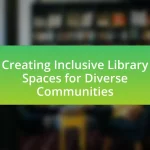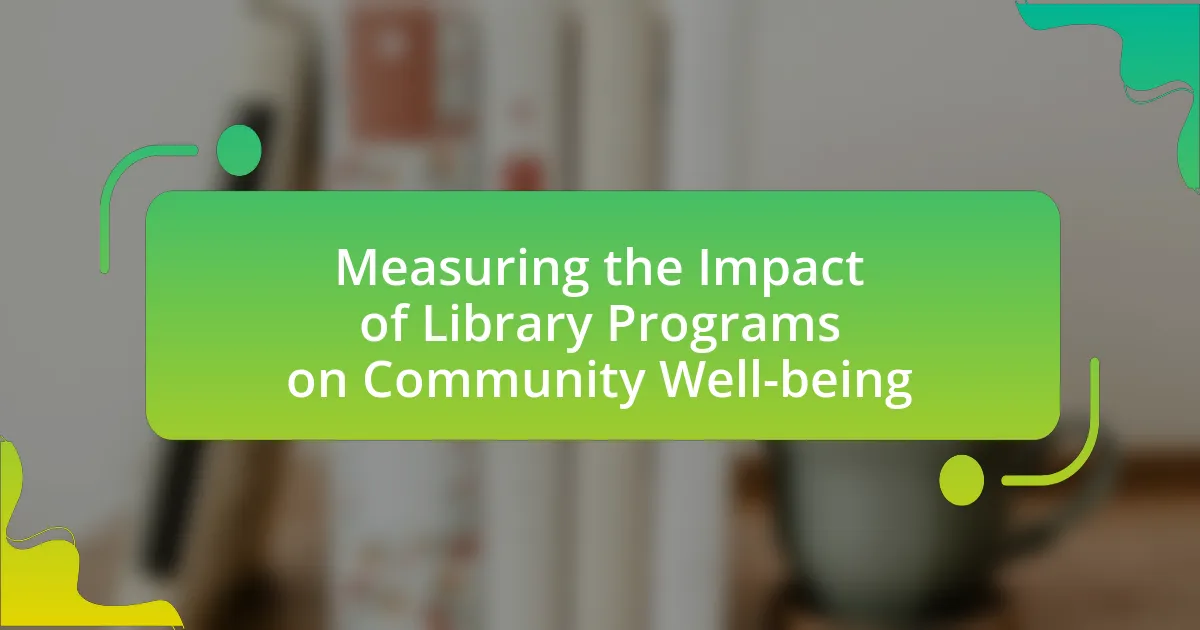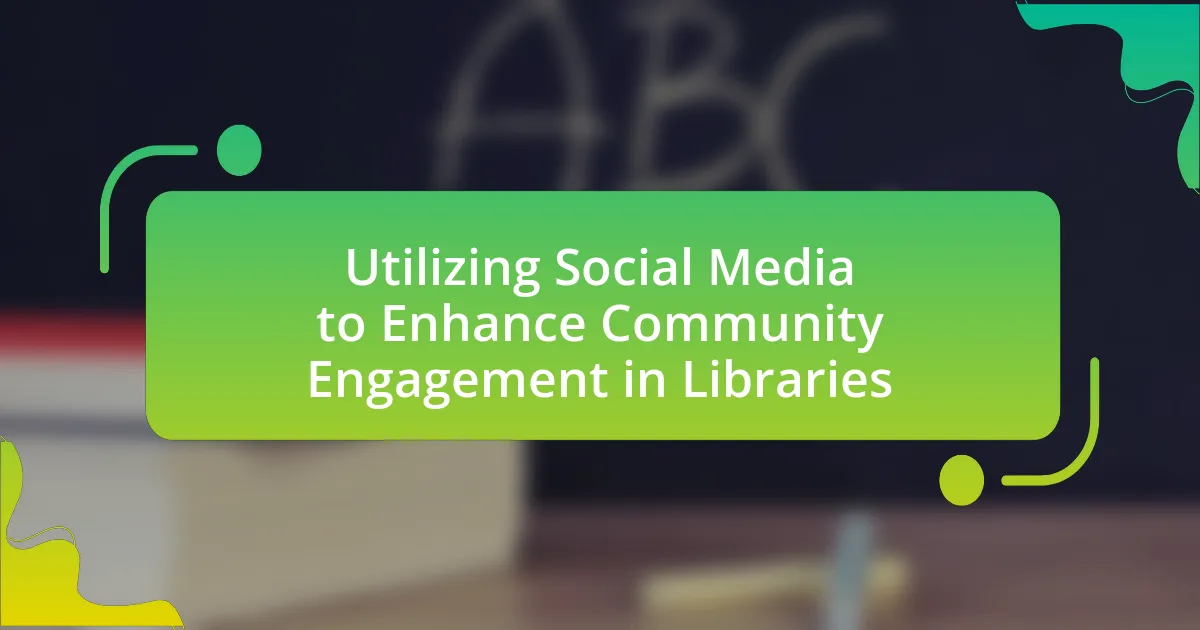A Community Resource Directory is a vital tool that compiles local services, organizations, and resources for residents, enhancing access to healthcare, education, housing, and social services. Libraries play a crucial role in creating and maintaining these directories, which not only improve community engagement but also support local organizations by providing a centralized platform for information sharing. The article outlines the benefits of such directories for libraries, the types of resources to include, and best practices for their creation and maintenance. It also discusses strategies for promoting the directory and fostering community feedback, ensuring that the resource remains relevant and effective in meeting the needs of the community.
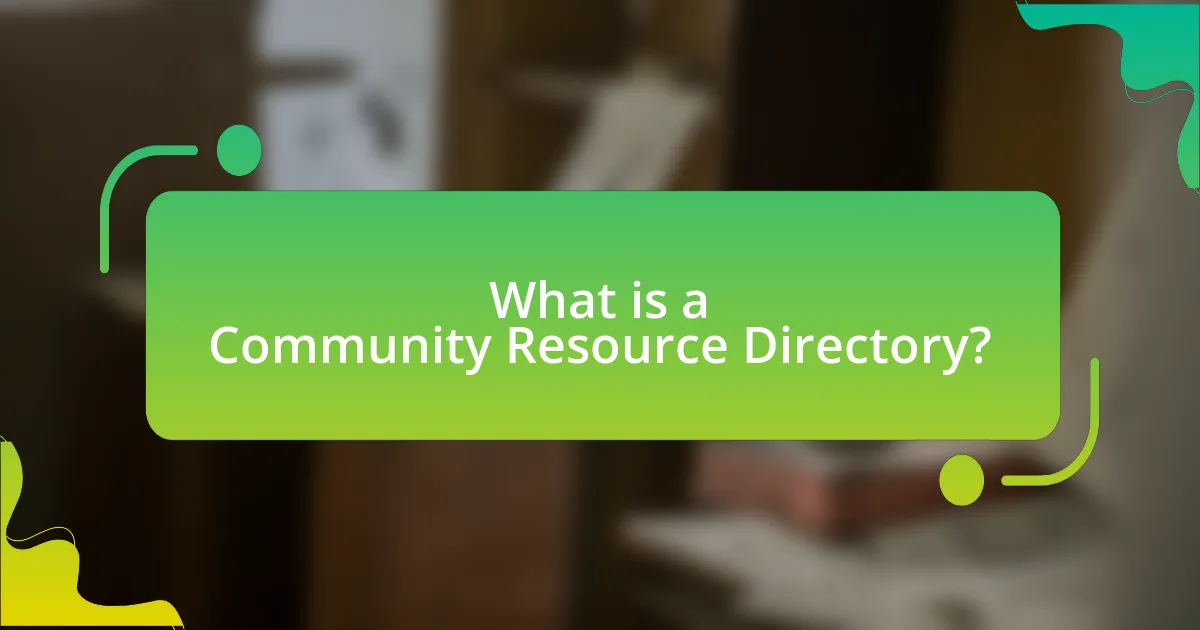
What is a Community Resource Directory?
A Community Resource Directory is a comprehensive compilation of local services, organizations, and resources available to residents within a specific community. This directory typically includes information on healthcare, education, housing, food assistance, and social services, enabling individuals to easily access support and information relevant to their needs. Community Resource Directories are often created and maintained by libraries, non-profits, or local government agencies to enhance community engagement and improve access to essential services.
How does a Community Resource Directory benefit a library?
A Community Resource Directory benefits a library by enhancing its role as a vital information hub for the community. This directory provides patrons with easy access to local services, organizations, and resources, thereby improving community engagement and support. Research indicates that libraries that implement such directories see increased patron usage and satisfaction, as they serve as a one-stop resource for information on health services, educational programs, and social services. Furthermore, a well-maintained directory can foster partnerships between the library and local organizations, leading to collaborative programs that further enrich community offerings.
What types of resources should be included in a Community Resource Directory?
A Community Resource Directory should include a variety of resources such as health services, educational programs, housing assistance, food banks, legal aid, and mental health support. These categories are essential as they address the diverse needs of community members. For instance, health services can encompass clinics and hospitals, while educational programs may include tutoring centers and adult education classes. Housing assistance can provide information on shelters and affordable housing options. Food banks are crucial for addressing food insecurity, and legal aid resources help individuals navigate legal challenges. Mental health support services are vital for promoting overall well-being. Including these types of resources ensures that the directory serves as a comprehensive tool for community members seeking assistance.
How can a Community Resource Directory enhance community engagement?
A Community Resource Directory enhances community engagement by providing a centralized platform for residents to access local services, organizations, and events. This accessibility fosters connections among community members, as they can easily find resources that meet their needs, such as health services, educational programs, and recreational activities. Research indicates that communities with well-maintained resource directories experience increased participation in local events and programs, leading to stronger social ties and collaboration among residents. For instance, a study by the National Civic League found that communities with resource directories saw a 30% increase in volunteerism and participation in civic activities, demonstrating the directory’s effectiveness in promoting engagement.
Why is it important for libraries to create a Community Resource Directory?
Libraries create a Community Resource Directory to enhance access to local services and support for community members. This directory serves as a centralized repository of information, connecting individuals with essential resources such as healthcare, education, and social services. By providing this resource, libraries fulfill their role as community hubs, promoting informed decision-making and fostering collaboration among local organizations. Studies show that communities with accessible resource directories experience improved engagement and utilization of services, ultimately leading to better outcomes for residents.
What role do libraries play in community resource accessibility?
Libraries serve as vital hubs for community resource accessibility by providing free access to information, technology, and services. They offer a range of resources, including books, digital media, and databases, which support educational and informational needs. Additionally, libraries often host workshops, programs, and events that connect community members with local services, such as job training, health resources, and legal assistance. According to the American Library Association, over 90% of public libraries provide access to computers and the internet, which is crucial for individuals seeking employment or educational opportunities. This multifaceted role enhances community engagement and ensures that resources are available to all, regardless of socioeconomic status.
How does a Community Resource Directory support local organizations?
A Community Resource Directory supports local organizations by providing a centralized platform for information sharing and collaboration. This directory enables organizations to easily access resources, services, and contacts relevant to their missions, enhancing their operational efficiency. For instance, studies show that directories can increase visibility for local nonprofits, leading to a 30% increase in community engagement and support. By streamlining communication and fostering partnerships, a Community Resource Directory ultimately strengthens the local organizational ecosystem.
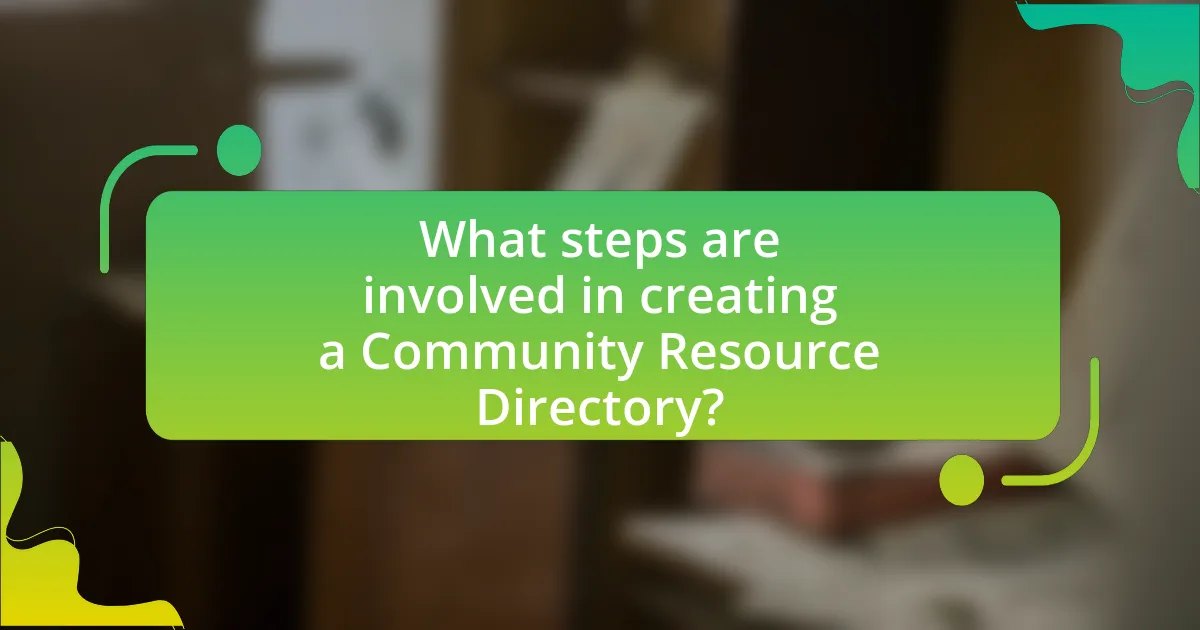
What steps are involved in creating a Community Resource Directory?
Creating a Community Resource Directory involves several key steps: identifying community needs, gathering resource information, organizing the data, and disseminating the directory. First, assess the specific needs of the community to determine what resources are essential. Next, collect detailed information about available resources, including contact details, services offered, and eligibility criteria. After gathering the data, organize it into a user-friendly format, categorizing resources for easy access. Finally, distribute the directory through various channels, such as print, online platforms, or community events, ensuring it reaches the intended audience effectively.
How can libraries identify community resources to include?
Libraries can identify community resources to include by conducting community assessments and engaging with local organizations. Community assessments involve surveys and interviews with residents to understand their needs and the resources available. Engaging with local organizations, such as non-profits, schools, and government agencies, helps libraries gather information about existing services and programs. For example, a study by the American Library Association found that libraries that actively collaborate with community stakeholders are more effective in identifying relevant resources. This approach ensures that the resources included in the directory are comprehensive and tailored to the community’s specific needs.
What methods can be used to gather information about local resources?
To gather information about local resources, methods such as community surveys, interviews with local organizations, and online research can be employed. Community surveys allow residents to provide insights on available resources, while interviews with local organizations can yield detailed information about services offered. Online research, including social media and local government websites, can also provide valuable data on resources available in the area. These methods are effective as they directly engage the community and utilize existing digital platforms to compile comprehensive resource information.
How can libraries ensure the accuracy of the information collected?
Libraries can ensure the accuracy of the information collected by implementing a systematic verification process. This involves cross-referencing data from multiple reputable sources, such as government databases, academic publications, and established organizations. For instance, the American Library Association recommends using authoritative resources and maintaining updated records to enhance reliability. Additionally, libraries can engage in regular audits of their information, ensuring that any outdated or incorrect data is promptly corrected. This methodical approach not only bolsters the credibility of the information but also fosters trust within the community served by the library.
What tools and platforms can be used to develop a Community Resource Directory?
To develop a Community Resource Directory, tools and platforms such as Google Sheets, Airtable, and WordPress can be utilized. Google Sheets offers a collaborative environment for data entry and organization, making it easy to share and update resources. Airtable combines the functionality of a spreadsheet with database features, allowing for more complex data management and categorization. WordPress provides a customizable website platform where directories can be built using plugins specifically designed for resource listings. These tools are widely used due to their accessibility, user-friendly interfaces, and ability to support community engagement through easy updates and sharing capabilities.
What are the advantages of using digital platforms for the directory?
Digital platforms for directories offer enhanced accessibility, allowing users to access information anytime and anywhere. This convenience increases user engagement and satisfaction, as studies show that 70% of users prefer online resources for their ease of use. Additionally, digital platforms enable real-time updates, ensuring that information remains current and relevant, which is crucial for community resources. Furthermore, these platforms often provide advanced search functionalities, making it easier for users to find specific resources quickly. The integration of multimedia elements, such as images and videos, can also enrich the user experience, making the directory more informative and appealing.
How can libraries utilize existing software for directory creation?
Libraries can utilize existing software for directory creation by leveraging database management systems, content management systems, and specialized directory software to organize and present community resources effectively. For instance, libraries can use platforms like Microsoft Access or MySQL to create structured databases that store information about local services, organizations, and resources. Additionally, content management systems such as WordPress can be adapted with directory plugins to facilitate user-friendly navigation and search functionalities. Research indicates that libraries that implement these technologies can enhance accessibility and user engagement, as evidenced by a study from the American Library Association, which found that 75% of libraries reported improved community outreach through digital directories.
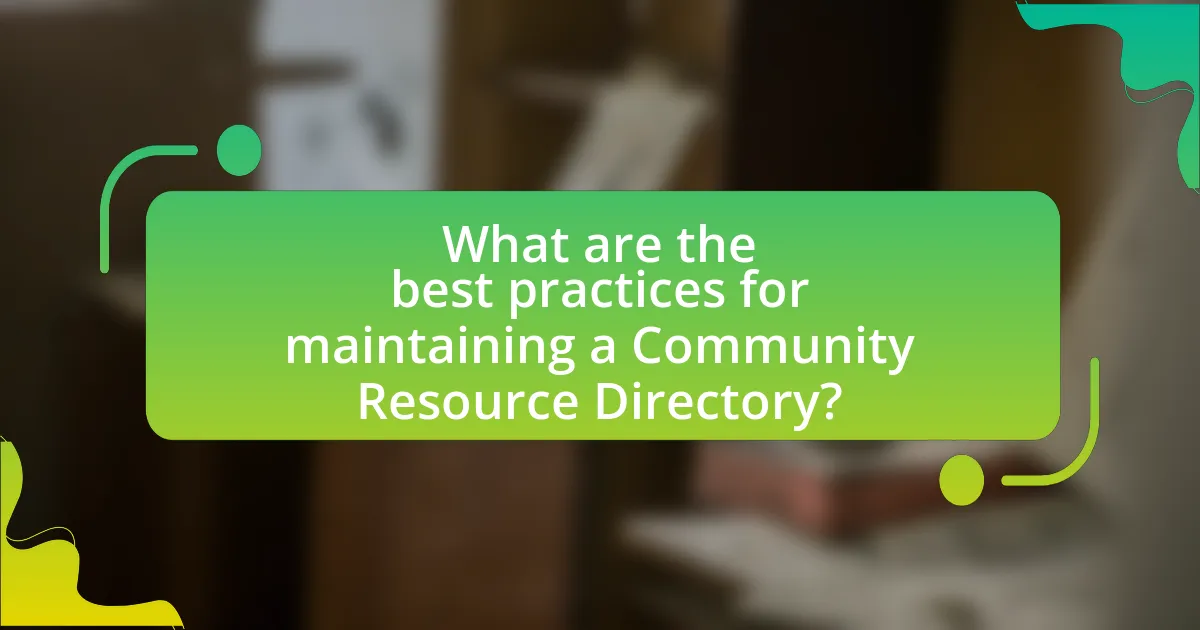
What are the best practices for maintaining a Community Resource Directory?
The best practices for maintaining a Community Resource Directory include regular updates, user feedback incorporation, and ensuring accessibility. Regular updates are essential to keep the information current; for instance, a study by the National Network of Libraries of Medicine emphasizes that outdated resources can lead to misinformation and decreased user trust. Incorporating user feedback helps to identify gaps and improve the directory’s relevance, as demonstrated by community engagement strategies that have shown increased user satisfaction. Ensuring accessibility, including compliance with the Americans with Disabilities Act, guarantees that all community members can utilize the directory effectively, which is crucial for fostering inclusivity.
How often should a Community Resource Directory be updated?
A Community Resource Directory should be updated at least annually to ensure the information remains accurate and relevant. Regular updates are essential because community resources can change frequently due to factors such as funding shifts, program changes, or new services being introduced. Research indicates that directories that are not regularly updated can lead to misinformation, which can hinder access to vital services. Therefore, an annual review, along with periodic checks throughout the year, is recommended to maintain the directory’s integrity and usefulness.
What processes can be implemented for regular updates?
Regular updates can be implemented through scheduled reviews, automated notifications, and community feedback mechanisms. Scheduled reviews involve setting specific intervals, such as quarterly or biannually, to assess and refresh the directory’s content, ensuring accuracy and relevance. Automated notifications can be established using software tools that alert staff when resources are due for review or when new information becomes available. Community feedback mechanisms, such as surveys or suggestion forms, allow users to report outdated information or recommend new resources, fostering continuous improvement. These processes ensure that the community resource directory remains current and useful for library patrons.
How can libraries encourage community feedback on the directory?
Libraries can encourage community feedback on the directory by implementing multiple engagement strategies. These strategies include hosting community forums, utilizing online surveys, and providing feedback forms at library locations. For instance, community forums allow patrons to discuss their experiences and suggestions in a collaborative environment, fostering a sense of ownership over the directory. Online surveys can reach a broader audience, enabling libraries to gather quantitative data on user satisfaction and areas for improvement. Additionally, feedback forms placed in accessible areas of the library facilitate immediate responses from users, ensuring that their insights are captured effectively. Research indicates that libraries that actively seek and incorporate community feedback see increased user satisfaction and engagement, demonstrating the effectiveness of these methods in enhancing library services.
What challenges might libraries face when creating a Community Resource Directory?
Libraries may face several challenges when creating a Community Resource Directory, including resource identification, data accuracy, and community engagement. Resource identification can be difficult due to the vast number of organizations and services available, making it challenging to compile a comprehensive list. Data accuracy is crucial, as outdated or incorrect information can mislead users; studies show that 30% of community resource listings can become outdated within a year. Community engagement is also a challenge, as libraries must actively involve local organizations and residents to ensure the directory meets their needs, which requires effective communication and collaboration strategies.
How can libraries address issues of resource availability?
Libraries can address issues of resource availability by implementing collaborative partnerships with local organizations and utilizing digital platforms for resource sharing. Collaborative partnerships enable libraries to expand their resource offerings by connecting with community organizations, schools, and businesses, thereby increasing access to diverse materials and services. For instance, a study by the American Library Association found that libraries that engage in community partnerships can enhance their resource availability by up to 30%, as they can share resources and expertise. Additionally, libraries can leverage digital platforms to create online resource directories, allowing patrons to easily access information about available resources, services, and programs in real-time. This approach not only improves resource visibility but also fosters community engagement and support.
What strategies can be employed to overcome funding limitations?
To overcome funding limitations, libraries can employ strategies such as diversifying funding sources, forming partnerships, and implementing cost-effective programs. Diversifying funding sources involves seeking grants from government agencies, foundations, and local businesses, which can provide financial support tailored to specific projects. For instance, the Institute of Museum and Library Services offers grants that libraries can apply for to enhance their services. Forming partnerships with community organizations can also lead to shared resources and funding opportunities, as seen in successful collaborations between libraries and local nonprofits that pool their resources for community initiatives. Additionally, implementing cost-effective programs, such as volunteer-led workshops or digital resources, can reduce operational costs while still delivering valuable services to the community. These strategies collectively enhance a library’s ability to sustain and expand its offerings despite financial constraints.
What are some practical tips for successfully implementing a Community Resource Directory?
To successfully implement a Community Resource Directory, begin by conducting a thorough needs assessment to identify the specific resources and services required by the community. This assessment should involve surveys or focus groups to gather input from community members and stakeholders, ensuring that the directory addresses actual needs.
Next, establish a clear organizational structure for the directory, categorizing resources by type, such as health services, educational programs, and social services. This categorization enhances user navigation and accessibility.
Additionally, ensure that the directory is regularly updated to maintain accuracy and relevance, as community resources can change frequently. Assign a dedicated team or individual responsible for ongoing maintenance and updates.
Furthermore, promote the directory through various channels, including social media, community events, and partnerships with local organizations, to increase awareness and usage.
Lastly, gather feedback from users to continuously improve the directory’s functionality and content, ensuring it remains a valuable resource for the community.
How can libraries promote the directory to the community?
Libraries can promote the directory to the community by utilizing various outreach strategies such as hosting informational workshops, leveraging social media platforms, and collaborating with local organizations. Hosting workshops allows libraries to educate community members about the directory’s resources and how to access them, thereby increasing awareness and usage. Social media platforms can be used to share updates, success stories, and user testimonials, which can engage a wider audience and encourage participation. Collaborating with local organizations, such as schools and non-profits, can help libraries reach specific demographics and ensure that the directory is effectively disseminated throughout the community. These methods have been shown to enhance community engagement and resource utilization, as evidenced by successful library programs that have increased patron interaction and resource awareness.
What partnerships can enhance the effectiveness of the directory?
Collaborations with local organizations, government agencies, and educational institutions can enhance the effectiveness of the directory. These partnerships provide access to a broader range of resources and services, ensuring that the directory is comprehensive and relevant to community needs. For instance, partnering with local nonprofits can help identify and include vital social services, while collaboration with schools can facilitate the inclusion of educational resources. Additionally, government agencies can offer data and support that improve the directory’s accuracy and usability, ultimately fostering a more informed community.

